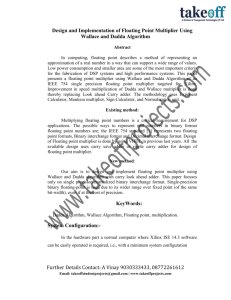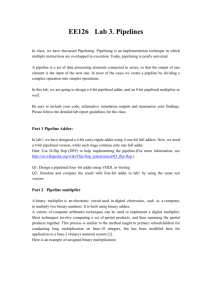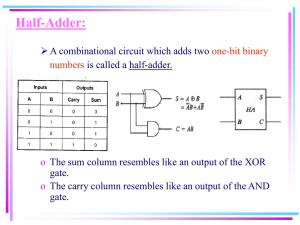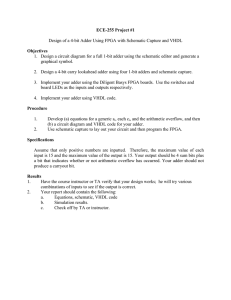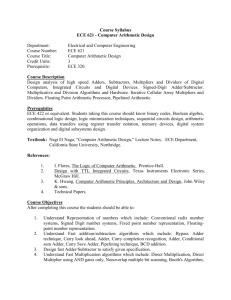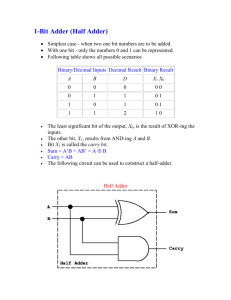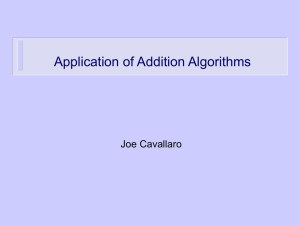Research Journal of Applied Sciences, Engineering and Technology 9(1): 53-57,... ISSN: 2040-7459; e-ISSN: 2040-7467
advertisement
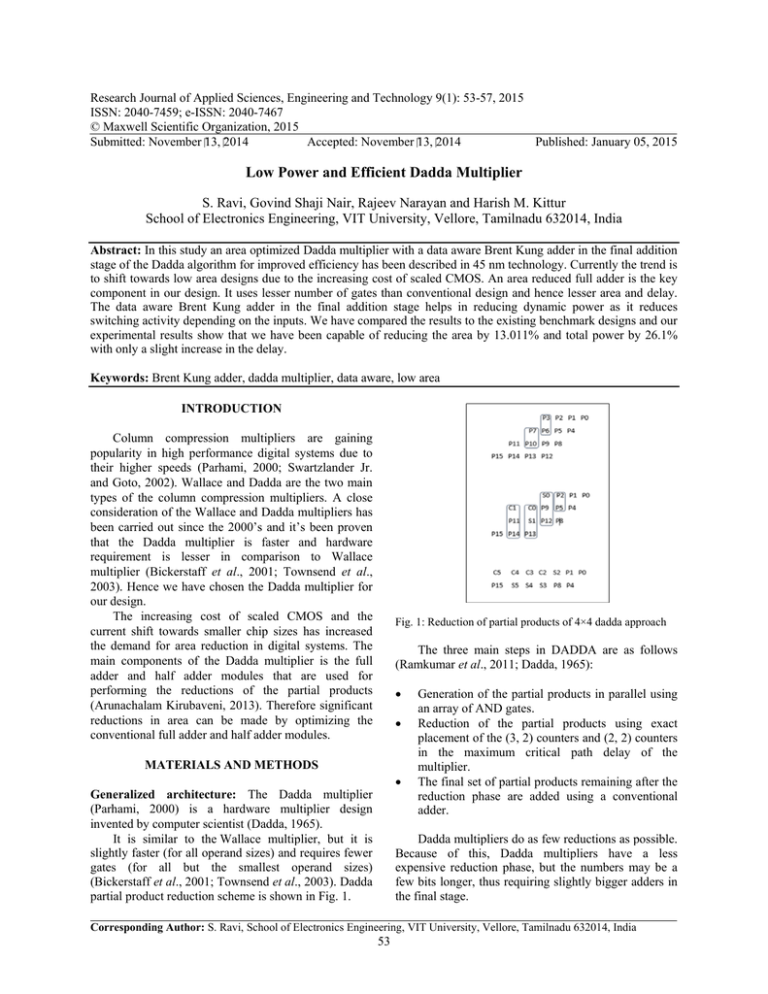
Research Journal of Applied Sciences, Engineering and Technology 9(1): 53-57, 2015
ISSN: 2040-7459; e-ISSN: 2040-7467
© Maxwell Scientific Organization, 2015
Submitted: November 13, 2014
Accepted: November 13, 2014
Published: January 05, 2015
Low Power and Efficient Dadda Multiplier
S. Ravi, Govind Shaji Nair, Rajeev Narayan and Harish M. Kittur
School of Electronics Engineering, VIT University, Vellore, Tamilnadu 632014, India
Abstract: In this study an area optimized Dadda multiplier with a data aware Brent Kung adder in the final addition
stage of the Dadda algorithm for improved efficiency has been described in 45 nm technology. Currently the trend is
to shift towards low area designs due to the increasing cost of scaled CMOS. An area reduced full adder is the key
component in our design. It uses lesser number of gates than conventional design and hence lesser area and delay.
The data aware Brent Kung adder in the final addition stage helps in reducing dynamic power as it reduces
switching activity depending on the inputs. We have compared the results to the existing benchmark designs and our
experimental results show that we have been capable of reducing the area by 13.011% and total power by 26.1%
with only a slight increase in the delay.
Keywords: Brent Kung adder, dadda multiplier, data aware, low area
INTRODUCTION
Column compression multipliers are gaining
popularity in high performance digital systems due to
their higher speeds (Parhami, 2000; Swartzlander Jr.
and Goto, 2002). Wallace and Dadda are the two main
types of the column compression multipliers. A close
consideration of the Wallace and Dadda multipliers has
been carried out since the 2000’s and it’s been proven
that the Dadda multiplier is faster and hardware
requirement is lesser in comparison to Wallace
multiplier (Bickerstaff et al., 2001; Townsend et al.,
2003). Hence we have chosen the Dadda multiplier for
our design.
The increasing cost of scaled CMOS and the
current shift towards smaller chip sizes has increased
the demand for area reduction in digital systems. The
main components of the Dadda multiplier is the full
adder and half adder modules that are used for
performing the reductions of the partial products
(Arunachalam Kirubaveni, 2013). Therefore significant
reductions in area can be made by optimizing the
conventional full adder and half adder modules.
Fig. 1: Reduction of partial products of 4×4 dadda approach
The three main steps in DADDA are as follows
(Ramkumar et al., 2011; Dadda, 1965):
•
•
MATERIALS AND METHODS
•
Generalized architecture: The Dadda multiplier
(Parhami, 2000) is a hardware multiplier design
invented by computer scientist (Dadda, 1965).
It is similar to the Wallace multiplier, but it is
slightly faster (for all operand sizes) and requires fewer
gates (for all but the smallest operand sizes)
(Bickerstaff et al., 2001; Townsend et al., 2003). Dadda
partial product reduction scheme is shown in Fig. 1.
Generation of the partial products in parallel using
an array of AND gates.
Reduction of the partial products using exact
placement of the (3, 2) counters and (2, 2) counters
in the maximum critical path delay of the
multiplier.
The final set of partial products remaining after the
reduction phase are added using a conventional
adder.
Dadda multipliers do as few reductions as possible.
Because of this, Dadda multipliers have a less
expensive reduction phase, but the numbers may be a
few bits longer, thus requiring slightly bigger adders in
the final stage.
Corresponding Author: S. Ravi, School of Electronics Engineering, VIT University, Vellore, Tamilnadu 632014, India
53
Res. J. App. Sci. Eng. Technol., 9(1): 53-57, 2015
Optimized proposed architecture:
Low area full adder: As mentioned earlier, the full
adder module is one of the main components of the
Dadda multiplier. The conventional full adder shown in
Fig. 2 has 2 EXOR gates, 2 AND gates and 1 OR gate.
The Sum and Carry formula in conventional full
adder is:
Fig. 3: Optimized full adder circuit diagram
Sum = (A^B^Cin)
Carry = ((Cin. (A^B)) + (A.B))
After careful evaluation of the 10 Transistor Full
adder design mentioned in Rani et al. (2011), we were
able to design a full adder using just 2 EXNOR gates
and 1 MUX.
The Sum and Carry formula for proposed full
adder is:
X1 = ~(A^B)
Fig. 4: Carry generation of 4-bit Brent Kung adder
Sum = ~(X1^Cin)
Carry = X1? A: Cin ----> {Describes a MUX}
Thus the proposed full adder shown in Fig. 3 not
only reduces area and number of components but delay
as well since propagation delay is reduced due to less
number of components.
Data aware brent kung adder: The Brent-Kung adder
is a parallel prefix adder. Parallel prefix adders are
special class of adders that are based on the use of
generate and propagate signals. Simpler Brent-Kung
adders have been proposed to solve the disadvantages
of Kogge-Stone adders. The cost and wiring complexity
is greatly reduced. But the logic depth of Brent-Kung
adders increases to 2log (2n-1), so the speed is lower
(Pudi and Sridharan, 2012). We propose a method to
reduce delay and power consumed by the Brent Kung
adder by analyzing and dividing the inputted data into
blocks that will only be added if it holds any value at
all. Hence the inputted values are initially compared
before deciding up to how many of theadder blocks
should be activated. This approach can easily be
integrated to the existing design of the Brent Kung
adder, thus making it more efficient. The block diagram
of 4-bit Brent-Kung adder is shown in Fig. 4.
Fig. 5: Preprocess circuit diagram for 4-bit Brent Kung adder
The 4-Bit Brent Kung adder module has 3 main
stages of operation. They are explained in detail below.
Preprocess-generate and propagate:
Propagate: A XOR B
Generate: A and B
The preprocess stage shown in Fig. 5 calculates the
initial propagate and generate signals directly from the
inputs using the formulae mentioned above. Since this
is 4-bit module, 4 initial propagate and generate signals
will be calculated as shown in the circuit diagram.
Black dot functionality:
Propagate: P0 and P1
Generate: G0 and P1+G1
The second stage calculates both the internal as
well as final carry using the initial generate and
propagate signals and using the black dot operation as
shown in Fig. 4. The Black dot operation takes in 2
pairs of generate and propagate signals and gives a
single pair of generate and propagate signal as output as
Fig. 2: Conventional full adder circuit diagram
54
Res. J. App. Sci. Eng. Technol., 9(1): 53-57, 2015
The post process shown in Fig. 7 uses the generate
(carry) signals outputted at the end of the second stage
in calculating the sum and final output carry using the
formulae that are mentioned above.
The final stage of the 64-bit Dadda multiplier is the
addition operation which is usually performed by
conventional adders. Here we have implemented the
final stage addition using two 64-bitdata aware Brent
Kung adders connected in a cascading manner. For the
case of 64-bit bit data aware Brent Kung adder, 16 four
bit BrentKung adders, each with its own enable line
were made and joined such that they could perform a 64
bit addition operation to generate a 64 bit output.
Here the adder is made data aware by first
analyzing the input to find the highest MSB bit in the
two operands and also to compare as to which operand
is bigger using the algorithm depicted above. Based on
the results drawn from it, the 64-bit adder only activates
up to that many 4-bit Brent Kung adder modules using
the enable lines (Fig. 8).
The remaining 4-bit modules are deactivated and
hence switching activity is reduced leading to reduction
in dynamic power consumption (Zhou and Guo, 2008)
making the Dadda multiplier more efficient.
For example, consider 2 inputs (63:0) A and (63:0)
B are fed into the Brent Kung adder. A has a higher
MSB than B and the MSB of A is at the 52nd bit. In this
case after checking the inputs, the enable lines 0 to 13
will be activated while 14 and 15 will be deactivated. If
the MSB bit was at 10th bit, then only enable lines 0 to
2 will be activated while the remaining enable lines 3 to
Fig. 6: Circuit diagram depicting black dot functionality
Fig. 7: Postprocess circuit diagram for 4-bit Brent Kung adder
per the formulae mentioned above is shown in Fig. 6.
Hence at the end of second stage, we would have
obtained 4 pairs of final propagate and generate signals.
The final generate signals outputted represent the carry
of that stage.
Postprocess-sum and carry:
SUM [i] = A [i] ^B [i] ^C [i-1]
= P [i] ^C [i-1]
CARRY = FINAL GENERATE
CALCULATED ON THE MSB
SIGNAL
Fig. 8: Algorithm used for selection of enable lines based on input (data aware)
Fig. 9: Sixty four bit Brent Kung adder made of 4-bit Brent Kung modules with specific enable lines for each module
55
Res. J. App. Sci. Eng. Technol., 9(1): 53-57, 2015
15 will be deactivated. Hence depending on the data in
the inputs, the switching activity varies resulting in
more efficient dynamic power management.
The diagram Fig. 9 above depicts a 64-bit data
aware Brent Kung adder formed by the cascaded
network of 16 4-bit Brent Kung adder modules, each
with a specific enable line.
RESULTS AND DISCUSSION
For the RTL synthesis we have used the
CADENCE RTL compiler. For the process we first
created a setup file for 45 nm technology using the slow
library functions for finding the specifications for the
worst case scenario. In the setup files we called the top
module of each architecture and giving a virtual clock
we synthesized to find various stipulations like Time
Slack, Leakage and Dynamic Power, Total Area and
The number of cells. The various readings obtained
from the RTL synthesis of all the architectures are:
Dadda with conventional Full Adder shown in
Table 1, Dadda with proposed full adder shown in
Table 2. Proposed architecture Table 2 values are
positive to move the architecture further.
After estimating and analyzing the various
parameters of the design shown in Table 3 and 4 after
synthesis, we can come to the conclusion that area
optimized Dadda multiplier performs better than the
Table 1: Dadda with conventional full adder
Size
Area (um2)
Delay (nsec)
8×8
517
3.800
16×16
2183
6.310
32×32
8641
11.440
64×64
38412
21.673
Power (mW)
0.194
0.708
2.068
5.933
Table 2: Dadda with proposed full adder
Size
Area (um2)
Delay (nsec)
8×8
449
3.700
16×16
1954
6.278
32×32
8110
11.386
64×64
33029
21.606
Power (mW)
0.181
0.679
2.048
5.743
Fig. 10: Physical view of area optimized dadda multiplier
with data aware Brent Kung adder in final stage
conventional Dadda multiplier. The percentage
decrease in the parameters between the conventional
Dadda and area optimized Dadda multipliers are shown
Table 5.
CONCLUSION
By using the proposed data aware Brent Kung
Adder in the final stage of the area optimized 64 bit
Dadda multiplier, we were able to reduce total power
by 26.1 and 22.6% when compared to conventional 64
bit Dadda multiplier and area optimized 64 bit Dadda
multiplier. Hence the proposed final Dadda multiplier is
more efficient in terms of power management and area
when compared to the conventional Dadda multiplier.
The proposed area efficient Dadda multiplier with
data aware Bret Kung adder in its final addition stage
was taken to the backend process and the final physical
view just before the generation of the GDSII file was
obtained.
The backend process of power plan, floor plan,
optimization and placement were all done in cadence
encounter tool using 45 nm technology. The total die
size was found to be 47733.97 um2. Figure 10 shown
above depicts the physical view of the area optimized
Dadda multiplier with Data aware Brent Kung adder in
final stage obtained using the Cadence encounter
software.
Table 3: Area optimized 64-bit dadda with conventional adder in
final stage
Parameters
64-bit dadda
Area (um2)
33029
Delay (nsec)
21.606
Power (mW)
5.743
REFERENCES
Arunachalam, T. and S. Kirubaveni, 2013. Analysis of
high speed multipliers. Proceeding of International
Conference on Communications and Signal
Processing (ICCSP, 2013), pp: 211-214.
Bickerstaff, K.C., E.E. Swartzlander and M.J. Schulte,
2001. Analysis of column compression multipliers.
Proceeding of 15th IEEE Symposium on Computer
Arithmetic, pp: 33-39.
Dadda, L., 1965. Some schemes for parallel multipliers.
Alta Freq., 34: 349-356.
Parhami, B., 2000. Computer Arithmetic. Oxford
University Press, New York.
Table 4: Area optimized 64-bit dadda with proposed adder in final
stage
Parameters
64-bit dadda
Area (um2)
33414
Delay (nsec)
30.400
Power (mW)
4.444
Table 5: Comparison between conventional dadda and area
optimized dadda multipliers
Size
Area (%)
Delay (%)
Power (%)
8×8
-13.15
-2.60
-6.70
16×16
-10.40
-0.51
-4.10
32×32
-6.14
-0.47
-0.96
64×64
-14.01
-0.31
-3.16
56
Res. J. App. Sci. Eng. Technol., 9(1): 53-57, 2015
Swartzlander Jr., E. and G. Goto, 2002. Computer
Arithmetic. In: Oklobdzija, V.G. (ed.), the
Computer Engineering Handbook. CRC Press,
Boca Raton, FL.
Townsend, W.J., E.E. Swartzlander and J.A. Abraham,
2003. A comparison of Dadda and Wallace
multiplier delays. Proceeding of SPIE Advanced
Signal Processing Algorithms, Architectures and
Implementations XIII, 5205: 552-560.
Zhou, Y. and H. Guo, 2008. Application specific low
power ALU design. Proceeding of IEEE/IFIP
International Conference on Embedded and
Ubiquitous Computing (EUC’08), pp: 214-220.
Pudi, V. and K. Sridharan, 2012. Low complexity
design of ripple carry and Brent-kung adders in
QCA. IEEE T. Nanotechnol., 11(1): 105-119.
Ramkumar, B., V. Sreedeep and H.M. Kittur, 2011. A
Design Technique for Faster Dadda Multiplier.
Retrieved form: http://arxiv.org/ftp/arxiv/papers/
1110/1110.3281.pdf.
Rani, T.E., M.A. Rani and R. Rao, 2011. Area
optimized low power arithmetic and logic unit.
Proceeding of 3rd International Conference on
Electronics Computer Technology (ICECT, 2011),
pp: 224-228.
57
